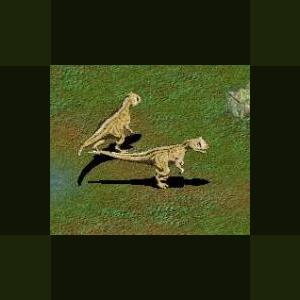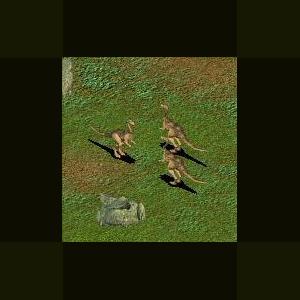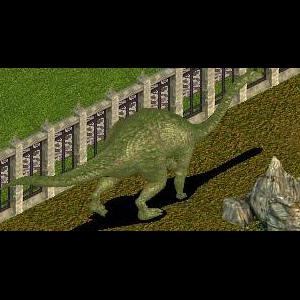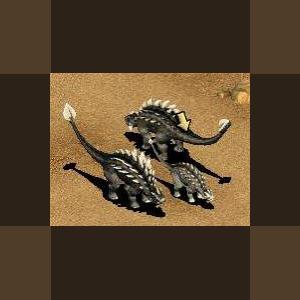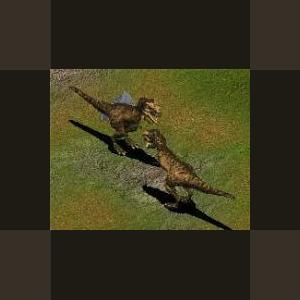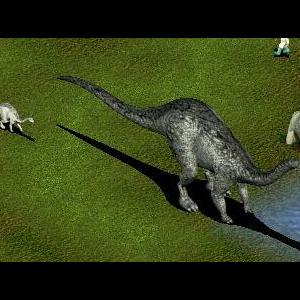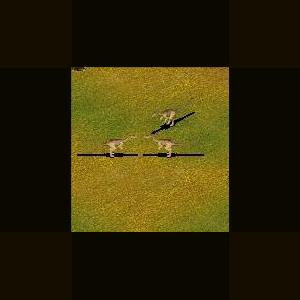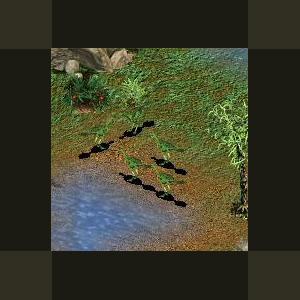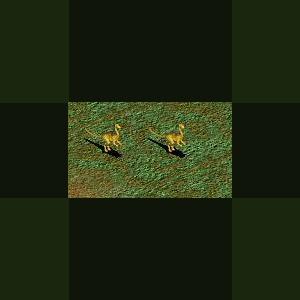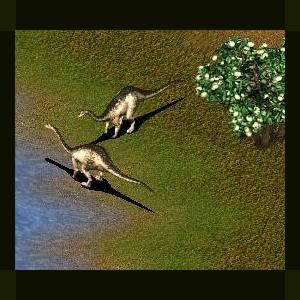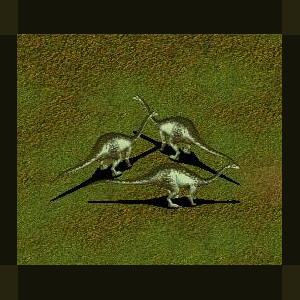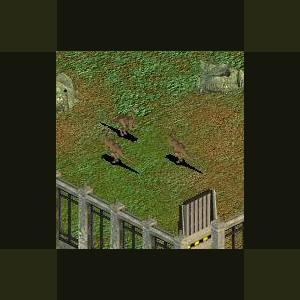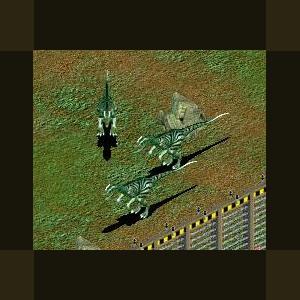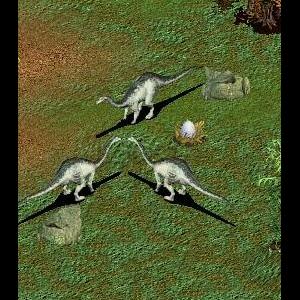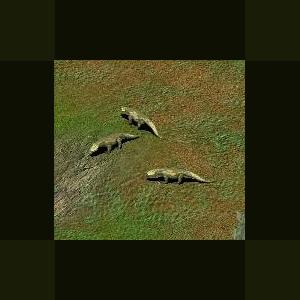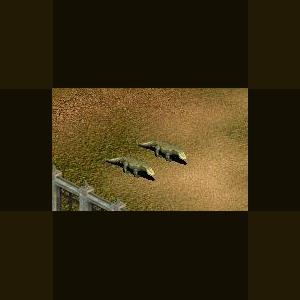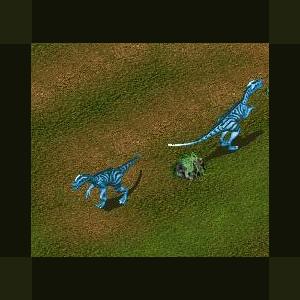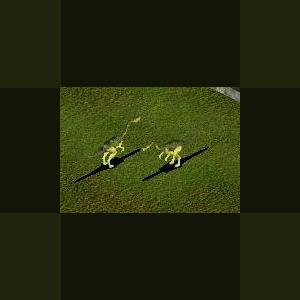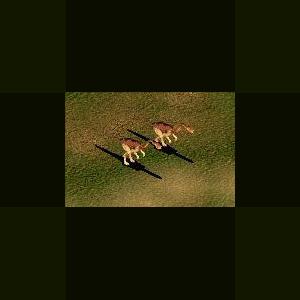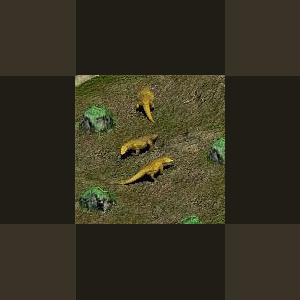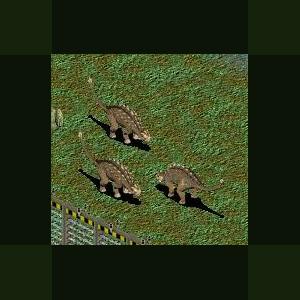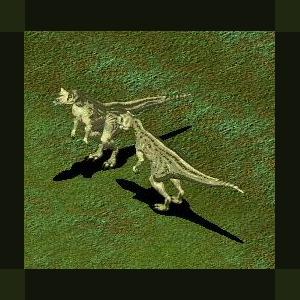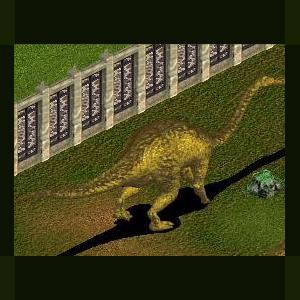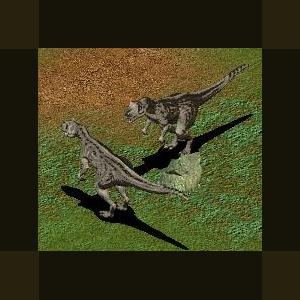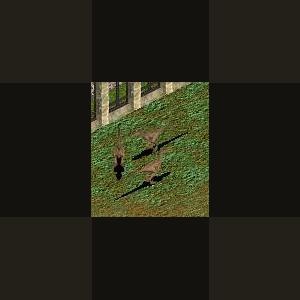Dinosaurs
Creatures from another age
241 files
-
Indosuchus by Moondawg
By Guest
Indosuchus raptorius was an abelisaurid dinosaur from the Late Cretaceous Period (65 to 70 million years ago - the Maastrichtian era),
A primitive theropod related to Abelisaurus. Like most theropods, Indosuchus was a bipedal carnivore. It was possibly 20 feet (6 meters) long, and had a crested skull, flattened on the top.
Because only some skull elements have been found, Indosuchus placement has been somewhat erratic. Although it's now somewhat firmly placed within the Abelisauridae, it has been also grouped with allosaurs and tyrannosaurs. The discovery of other abelisaurid species like Carnotaurus sastrei has helped clarify its position.
191 downloads
0 comments
Updated
-
Agilisaurus by Moondawg
By Guest
Acrocanthosaurus (pronounced ak-ro-KAN-tho-SAWR-us; meaning 'high-spined lizard') is a genus of allosauroid theropod dinosaur that existed in what is now North America during the mid-Cretaceous Period
The skull of Acrocanthosaurus, like most other allosauroids, was long, low and narrow. The weight-reducing opening in front of the eye socket (antorbital fenestra) was quite large, more than a quarter of the length of the skull and two-thirds of its height. The outside surface of the maxilla (upper jaw bone) and the upper surface of the nasal bone on the roof of the snout were not nearly as rough-textured as those of Giganotosaurus or Carcharodontosaurus. Long, low ridges arose from the nasal bones, running along each side of the snout from the nostril back to the eye, where they continued onto the lacrimal bones. This is a characteristic feature of all allosauroids. Unlike Allosaurus, there was no prominent crest on the lacrimal bone in front of the eye. The lacrimal and postorbital bones met to form a thick brow over the eye, as seen in carcharodontosaurids and the unrelated abelisaurids. Nineteen curved, serrated teeth lined each side of the upper jaw, but a tooth count for the lower jaw has not been published. Acrocanthosaurus teeth were wider than those of Carcharodontosaurus and did not have the wrinkled texture that characterized the carcharodontosaurids. The dentary (tooth-bearing lower jaw bone) was squared off at the front edge, as in Giganotosaurus, and shallow, while the rest of the jaw behind it became very deep. Acrocanthosaurus and Giganotosaurus shared a thick horizontal ridge on the outside surface of the surangular bone of the lower jaw, underneath the articulation with the skull.
235 downloads
Updated
-
Cetiosauriscus by Moondawg
By Guest
Cetiosauriscus (meaning "whale-lizard-like" i.e. "Cetiosaurus-like") was a close relative of Diplodocus and lived in the Middle to Late Jurassic Period of England.
It was first named by German palaeontologist Friedrich von Huene, in 1927 and is known from a series of vertebrae from the rear half of the skeleton. It has been estimated that this creature stood 6 metres high and was 15 metres in length, weighing about 9 tonnes.
It may have been preyed on by carnivores such as Megalosaurus and Eustreptospondylus.
183 downloads
0 comments
Updated
-
Gobisaurus by Moondawg
By Guest
Gobisaurus is an ankylosaur from the Upper Cretaceous Ulansuhai Formation (Nei Mongol Zizhiqu) of China.
The holotype consists of a skull and as yet undescribed postcranial remains. Along with its sister taxon Shamosaurus, Gobisaurus is "nested deep within the ankylosaurid lineage as the first successive outgroup to (the subfamily) Ankylosaurinae" (Vickaryous et. al., 2004). This is a large ankylosaur, with a skull measuring 46 cm. in length and 45 cm. across. The name means "Gobi (Desert) lizard," referring to its discovery by the Sino-Soviet Expeditions (1959–1960) in the Gobi Desert of Mongolia. The genus is monotypic, containing only G. domoculus.
237 downloads
0 comments
Updated
-
Alioramus by Moondawg
By Guest
Alioramus ( meaning 'different branch') is a genus of tyrannosaurid theropod dinosaur from the Late Cretaceous Period of Asia.
The type and only species, A. remotus, is known from a partial skull and three metatarsals recovered from Mongolian sediments which were
deposited in a humid floodplain between 70 to 65 million years ago. These remains were
named and described by Russian paleontologist Sergei Kurzanov in 1976. Its relationships
to other tyrannosaurid genera are unknown, but some experts believe Alioramus is closely
related to the contemporaneous Tarbosaurus, or is a juvenile of that genus.
While very little skeletal material is known, Alioramus was probably bipedal like most
theropods, and its sharp teeth indicate that it was a carnivore. It was smaller than
tyrannosaurids like Tarbosaurus and Tyrannosaurus, but its adult size is difficult to
estimate since it is known mainly from a skull, which may belong to a juvenile. Alioramus
is characterized by the row of five bony crests along the top of its snout, and also has
more teeth than any other tyrannosaurid. Its skull is lower than those of other
tyrannosaurids, but this might be a juvenile feature.
Alioramus was estimated at between 5 and 6 meters (16.5 to 20 ft) in length when
originally described by Sergei Kurzanov in 1976. Kurzanov, however, did not correct for
lengthening of the skull by deformation during fossilization, which may indicate a shorter
overall body length for this individual. If this specimen is a juvenile, then adult
Alioramus would have reached greater lengths, but no confirmed adult specimens are known.
Inspired by the Zoo Tek Brains Trust
285 downloads
Updated
-
Argentinosaurus by Moondawg
By Guest
Argentinosaurus (meaning "Argentina lizard") was a herbivorous sauropod dinosaur genus that was quite possibly the largest, heaviest land animal that ever lived. It developed on the island continent of South America during the middle of the Cretaceous Period (around 100 million years ago), after all of its more familiar Laurasian Jurassic kin — like Apatosaurus — had long disappeared.
Not much of Argentinosaurus has been recovered: just some back vertebrae, tibia, fragmentary ribs, and sacrum. One vertebra had a length of 1.3 meters and the tibia was about 155 centimeters (58 inches). However, the spectacular proportions of these bones and comparisons with other sauropod relatives allow paleontologists to estimate the size of the animal. Early reconstructions estimated Argentinosaurus at 35 meters (115 ft) in length and a weight of perhaps 80 to 100 tonnes. More recent estimates based on Saltasaurus, Opisthocoelicaudia and Rapetosaurus suggest sizes around 22-26 meters (72 - 85 ft).[1] It is the largest dinosaur for which there exists good evidence. Although it might have been smaller than Bruhathkayosaurus, which may have reached 44 meters (144 ft) in length and weighed 180 tons (however like Argentinosaurus it has been estimated shorter, at 28-34 meters (92-112 ft)), as well as the poorly known Amphicoelias fragilimus, which may have been up to 60 meters (200 ft) long, these estimates cannot be validated due to lack of evidence.
Vast wings on the vertebrae suited the attachment of massive muscles
The type species of Argentinosaurus, A. huinculensis, was described and published (by the Argentinian palaeontologists José F. Bonaparte and Rodolfo Coria) in 1993. Its more specific time-frame within the Cretaceous is the Albian to Cenomanian epochs, 112.2 to 93.5 million years ago. The fossil discovery site is in the Río Limay Formation in Neuquén Province, Argentina
Argentinosaurus is featured prominently in the permanent exhibition Giants of the Mesozoic at Fernbank Museum of Natural History in Atlanta, Georgia, USA. This display depicts a hypothetical encounter between Argentinosaurus and the carnivorous theropod dinosaur Giganotosaurus. Contemporary fossils of Cretaceous Period plants and animals are included in the exhibition, including two species of pterosaurs, providing a snapshot of a prehistoric ecosystem in what is now the modern Patagonia region of Argentina. At 123 feet (37 m) long, this skeletal reconstruction represents the largest dinosaur mount ever to be assembled.
603 downloads
0 comments
Updated
-
Megapnosaurus by Moondawg
By Guest
Megapnosaurus
Megapnosaurus (meaning "big dead lizard", from Greek = "big", = "not breathing", "dead", = "lizard") was a dinosaur of the theropod family Coelophysidae, formerly called Syntarsus (named by Raath, 1969), living during the Early Jurassic. It was renamed by American entomologist Dr. Michael Ivie (Montana State University of Bozeman), Polish Australian Dr. Adam Slipinski, and Polish Dr. Piotr Wegrzynowicz (Muzeum Ewolucji Instytutu Zoologii PAN of Warsaw), the scientists who discovered that the genus name Syntarsus was already taken by a colydiine beetle described in 1869.
Some paleontologists did not like the name Megapnosaurus. This was partially because taxonomists are generally expected to allow original authors of a name to correct any mistakes that may have arisen from their work. Raath was aware of the synonymy between the dinosaur Syntarsus and beetle Syntarsus, but the group who published Megapnosaurus had been led to believe Raath was deceased and proceeded accordingly. Megapnosaurus remains a valid name, though whether it can be treated as synonymous with Coelophysis is an open question.
It is almost identical to Coelophysis, and Yates (2005) suggested that Megapnosaurus was possibly synonymous with Coelophysis. In 2004, Raath co-authored two papers in which he argued that "Syntarsus" (Raath continued to use the old, invalid, name) was a junior synonym of Coelophysis.
Megapnosaurus measured up to 3 meters (10 ft) long from nose to tail and weighed about 32 kilograms (70 lb). The bones of 30 Megapnosaurus individuals were found together in a fossil bed in Zimbabwe, so paleontologists think it may have hunted in packs. The various fossils attributed to Megapnosaurus have been dated over a relatively large time span - the Hettangian, Sinemurian, and Pliensbachian stages of the Early Jurassic - meaning the fossils represent either a highly successful genus or a few closely related animals all currently assigned to Megapnosaurus.
Megapnosaurus is a good example of how dinosaurs spread across the globe from their ancestral habitats (which was possibly South America). This small predator had the same basic features found in early dinosaurs, and its appearance in both Africa and the southwestern U.S. indicates that it migrated through the continents, which at the time were joined together as Pangaea. There is species-level differentiation between the African and U.S. specimens, again supporting the migration and adaptation theories.
The African species (M. rhodesiensis) is known from almost 30 specimens. The North American species (M. kayentakatae) had small crests and may show an evolutionary step toward later and larger coelophysoids, such as the more derived Dilophosaurus. Both possess a weak joint between the premaxillary and the maxillary bones, creating a hooked premaxillary jaw. This led to the early hypothesis that dinosaurs such as these were scavengers, as the front teeth and bone structure were thought to be too weak to take down and hold struggling prey.
130 downloads
0 comments
Updated
-
Pedopenna by Moondawg
By Guest
Pedopenna
Pedopenna ("foot feather") was a small, feathered, maniraptoran dinosaur from the Daohugou Beds in China. It is possibly older than Archaeopteryx, though the age of the Daohugou Beds where it was found is debated. Some estimates give an Early Cretaceous age, but the latest radiometric dating shows them to be late Middle Jurassic (Callovian) (c.140-168 mya).
The name Pedopenna refers to the long pennaceous feathers on the metatarsus; daohugouensis refers to the locality of Daohugou, where the holotype was found. Pedopenna daohugouensis probably measured 1 meter (3 ft) or less in length, but since this species is only known from the hind legs, the actual length is difficult to estimate. Pedopenna is classified as a paravian (Paraves), the group of maniraptoran dinosaurs that includes Aves and their closest relatives.
The feet of Pedopenna resembled those of the related troodontids and dromaeosaurids (which together form the group Deinonychosauria), though were overall more primitive. In particular, the second toe of Pedopenna was not as specialized as in deinonychosaurs. While Pedopenna did have an enlarged claw and slightly shortened second toe, it was not as highly developed as the strongly curved, sickle-like claws of its relatives.
Xu and Zhang, who interpreted the Daohugou fossil beds where Pedopenna was found as mid to late Jurassic in age, used the presence of such a primitive member of the avian lineage, in combination with many primitive members of closely related lineages there, to support the idea that birds originated in Asia.
The avian affinities of Pedopenna are further evidence of the dinosaur-bird evolutionary relationship. Apart from having a very bird-like skeletal structure in its legs, Pedopenna was remarkable due to the presence of long pennaceous feathers on the metatarsus (foot). Some deinonychosaurs are also known to have these 'hind wings', but those of Pedopenna differ from those of animals like Microraptor. Pedopenna hind wings were smaller and more rounded in shape. The longest feathers were slightly shorter than the metatarsus, at about 55 mm (2 in) long. Additionally, the feathers of Pedopenna were symmetrical, unlike the asymmetrical feathers of some deinonychosaurs and birds. Since asymmetrical feathers are typical of animals adapted to flying, it is likely that Pedopenna represents an early stage in the development of these structures. While many of the feather impressions in the fossil are weak, it is clear that each possessed a rachis and barbs, and while the exact number of foot feathers is uncertain, they are more numerous than in the hind-wings of Microraptor. Pedopenna also shows evidence of shorter feathers overlying the long foot feathers, evidence for the presence of coverts as seen in modern birds. Since the feathers show fewer aerodynamic adaptations than the similar hind wings of Microraptor, and appear to be less stiff, suggests that if they did have some kind of aerodynamic function, it was much weaker than in deinonychosaurs and birds. Xu and Zhang, in their 2005 description of Pedopenna, suggested that the feathers could be ornamental, or even vestigial. It is possible that a hind wing was present in the ancestors of deinonychosaurs and birds, and later lost in the bird lineage, with Pedopenna representing an intermediate stage where the hind wings are being reduced from a functional gliding apparatus to a display or insulatory function.
132 downloads
0 comments
Updated
-
Oryctodromeus by Moondawg
By Guest
Oryctodromeus
Oryctodromeus (meaning "digging runner") was a genus of small ornithopod dinosaur, the fossilized remains of which have been found in rocks dating from the middle Cretaceous Blackleaf Formation of southwestern Montana (Cenomanian stage), roughly 95 million years ago. A member of the small, presumably fast-running herbivorous family Hypsilophodontidae, Oryctodromeus is the first dinosaur published that shows evidence of burrowing behavior.
Oryctodromeus is based on MOR 1636a, a partial skeleton of an adult individual including: the premaxillae (upper beak); part of the braincase; three neck, six back, seven hip, and twenty-three tail vertebrae; ribs; the shoulder girdle; an arm (minus the hand); both tibiae and an incomplete fibula; and a metatarsal. Two additional individuals, both juveniles about 55 to 65% the size of MOR 1636a, are represented by MOR 1636b. Unlike many other ornithopod dinosaurs, Oryctodromeus lacked bony tendons that stiffened the tail, which would have made moving about inside a small burrow easier. Additionally, it shows adaptations in the jaws, forelimbs, and pelvis that could have helped move and manipulate soil.
The authors pointed out that Oryctodromeus had only modest forelimb modifications in comparison to dedicated burrowing animals, like moles, echidnas, and wombats. Instead, it was comparable to, but somewhat more specialized for digging than animals that both run and burrow today, like aardwolves, cavies, hyenas, and rabbits. Because it was a biped, it could have a more modified forelimb without affecting its ability to run.
Under a cladistic analysis, Oryctodromeus was found to be basal within Euornithopoda and a close relative of the hypsilophodonts Orodromeus and Zephyrosaurus, which are also known from the Cretaceous of Montana. These two animals share adaptations with Oryctodromeus that may have been used for burrowing, such as a broad snout. Additionally, Orodromeus specimens have been found preserved in a similar way, suggesting that they too were in burrows. This would not be the first time that a hypsilophodont has been suggested as a burrower; Robert Bakker has informally claimed since the 1990s that Drinker, from the late Jurassic of Wyoming, lived in burrows, but this has yet to be published.
The three Oryctodromeus individuals were found buried within the remains of an underground den or burrow, measuring about 2 meters long (6.5 feet) and 70 centimeters wide (2.3 ft). The skeletons were densely packed and disarticulated, indicating that the animals died and decayed within the burrow. The burrow is similar to those made by hyenas and puffins today. It was filled with sand, and the resulting sandstone stands out against the surrounding mudstone and claystone.
There are two turns in the preserved burrow section, and smaller secondary sandstone cylinders of various sizes (a few centimeters or inches in cross-section at most) that were probably made by smaller animals sharing the burrow (commensal). The burrow closely fits the probable proportions of the adult dinosaur, another indication that it was the digger.
As a hypsilophodont, Oryctodromeus would have been a small, swift herbivore. This aspect, coupled with where it was discovered, gives it its name: Oryctodromeus cubicularis translates as "digging runner of the lair", in reference to its presumed lifestyle. The adult Oryctodromeus itself measured 2.1 m long (6.8 ft) and would have weighed about 22-32 kilograms (50-70 pounds), and the juveniles would have been about 1.3 m long (4.3 ft). The presence of juveniles with the adult suggests parental care, and that at least one motivation for burrowing was to rear the juveniles. The size of the juveniles suggests an extended period of parental care.
124 downloads
0 comments
Updated
-
Lufengosaurus by Moondawg
By Guest
Lufengosaurus
Lufengosaurus, (, meaning "Lufeng Lizard"), was a prosauropod dinosaur which lived during the Early Jurassic period in what is now southwestern China. At about 6 metres (20 ft) long, it was the first complete dinosaur skeleton mounted in China and a commemorative postage stamp was issued in 1958 to celebrate the event.
Named by C.C. Young in 1941, remains of the type species, L. huenei, were found in the Lower Lufeng Formation (Lower Jurassic) of Yunnan Province in China. A second species was named by Young a few years later. L. magnus was, as its name suggests, a significantly (up to 1/3rd) larger creature than L. huenei. Lufengosaurus is still found in Bajocian stage deposits of China, making it one of the few "prosauropod" genera to survive into the Middle Jurassic.
In 1981, Cooper suggested Lufengosaurus and Yunnanosaurus were species of the South African genus Massospondylus. However, a recent reanalysis of the skull of Lufengosaurus huenei establishes it as a distinct genus separate from either Massospondylus or Yunnanosaurus.
Like all prosauropods, Lufengosaurus had much longer hindlimbs than forelimbs and was probably bipedal some of the time, especially when browsing for food. It was herbivorous, although it had sharp claws (with an especially large thumb claw) and teeth. These features have been used to support claims that Lufengosaurus may have been at least partially omnivorous, but the sharp teeth witnessed in Lufengosaurus and other prosauropods are similar to those seen in iguanaian lizards - which are herbivorous.Alternatively, the claws may have been used for defense or raking foliage from trees.
162 downloads
0 comments
Updated
-
Sellosaurus by Moondawg
By Guest
Sellosaurus
Sellosaurus is the name given to a genus of prosauropod dinosaur that lived in Triassic Europe, 225 mya. Like other prosauropods, it had a thumb claw it may have used to defend itself, and reach for food.
Sellosaurus is one of the more well-known prosauropods. Over twenty skeletons have been discovered. These fossils comprise what is believed to be at least three separate species. The dinosaur Efraasia, a prosauropod from the same location, was long thought to be the same as Sellosaurus, but this has been recently disproved.
Sellosaurus is one of the more well-known prosauropods. Over twenty skeletons have been so far discovered. These fossils were found in strata dated to the middle Late Triassic and located in Nordwurttemberg, Germany. The remains comprise what is believed to be at least three separate species. The dinosaur Efraasia, a prosauropod from the same location, was long thought to be the same as Sellosaurus, but this has been recently disproved.
119 downloads
0 comments
Updated
-
Pisanosaurus by Moondawg
By Guest
Pisanosaurus
Pisanosaurus mertii (the name comes from "Pisano", who was an associate of the finder, and "saurus" meaning lizard or reptile) is a primitive bipedal Ornithischian dinosaur from the Late Triassic.
Pisanosaurus was 3.2 feet (1 meter) in length and 12 inches (30.48 centimeters) in height. Its weight estimate is just under 8.8 pounds (four kilograms). These estimates vary due to the incompleteness of the fossil.
Pisanosaurus is known from a fragmented skeleton found in Argentina. It is very basal within Ornithischia; the postcrania seem to lack any good ornithischian synapomorphy; it has even been suggested the fossil is a chimera.
Pisanosaurus (meaning "Pisano lizard") is a genus of primitive ornithischian dinosaur from the Late Triassic of what is now South America. It was a bipedal herbivore described by Argentine paleontologist Rodolfo Casamiquela in 1967. Only one species, the type, Pisanosaurus mertii, is known, based on one partially complete skeleton. The fossils were discovered in Argentina's Late Triassic Ischigualasto Formation, from around 228 to 216.5 million years ago.
The exact classification of Pisanosaurus has been the topic of debate by scientists for over 40 years; the current consensus is that Pisanosaurus is the oldest known ornithischian, part of a diverse group of dinosaurs which lived during nearly the entire span of the Mesozoic Era.
Based on the known fossil elements, Pisanosaurus was a small, lightly-built dinosaur approximately 1 m (3 ft 3 in) in length and 30 cm (12 in) in height. Its weight was between 2.27–9.1 kg (5–20 lb). These estimates vary due to the incompleteness of the fossil. The tail of Pisanosaurus has been reconstructed as being as long as the rest of the body, based on other early ornithischians, but as a tail has not been recovered, this is speculative. It was bipedal and, like all ornithischians, was probably exclusively herbivorous.
Pisanosaurus mertii was described by Argentine paleontologist Rodolfo Casamiquela in 1967. The name Pisanosaurus honors Juan A. Pisano, an Argentine paleontologist, while saurus is derived from the Greek sa????, meaning "lizard". Pisanosaurus is known from a single fragmented skeleton found in Argentina. It is based on a specimen given the designation PVL 2577, which was discovered in the Ischigualasto Formation.
The fossils of Pisanosaurus were discovered in Argentina's Ischigualasto Formation. Originally dated to the Middle Triassic, this formation is now believed to belong to the Late Triassic Carnian stage, around 228 to 216.5 million years ago. Pisanosaurus shared its habitat with rhynchosaurs, cynodonts, dicynodonts, prestosuchids, ornithosuchids, aetosaurs, and primitive dinosaurs. The early carnivorous dinosaur Herrerasaurus lived in this area and at this time, and may have fed upon Pisanosaurus.
121 downloads
0 comments
Updated
-
Dilophosaurus by Moondawg
By Guest
Dilophosaurus
Dilophosaurus was a theropod dinosaur from the Early Jurassic Period. The name is pronounced ("dy-LOH-fo-sawr-us") meaning 'two-crested lizard', because it had two crests (Greek di meaning 'two', lophos meaning 'crest' and sauros meaning 'lizard')
Dilophosaurus measured around six meters (20 ft) long and may have weighed half a ton.
The most distinctive characteristic of Dilophosaurus is the pair of rounded crests on its skull, possibly used for display. Studies by Robert Gay show no indication that sexual dimorphism was present in the skeleton of Dilophosaurus, but says nothing about crest variation. The teeth of Dilophosaurus are long, but have a fairly small base and expand basally. Another skull feature was a notch behind the first row of teeth, giving Dilophosaurus an almost crocodile-like appearance, similar to the putatively piscivorous spinosaurid dinosaurs. This "notch" existed by virtue of a weak connection between the premaxillary and maxillary bones of the skull. This conformation led to the early hypothesis that Dilophosaurus scavenged off dead carcasses, with the front teeth being too weak to bring down and hold large prey.
The first Dilophosaurus specimens were discovered by Sam Welles in the summer of 1942. The specimen was brought back to Berkeley for cleaning and mounting, where it was given the name Megalosaurus wetherilli. Returning to the same formation a decade later to determine from which time period the bones dated, Welles found a new specimen not far from the location of the previous discovery. The specimens were later renamed Dilophosaurus, based on the double crest clearly visible in the new skeleton.
There is another species of Dilophosaurus (D. sinensis), which may or may not belong to this genus. It is possibly closer to the bizarre Antarctic theropod Cryolophosaurus, based on the fact that the anterior end of the jugal does not participate in the internal antorbital fenestra and that the maxillary tooth row is completely in front of the orbit and ends anterior to the vertical strut of the lacrimal. This species was recovered from the Yunnan Province of China in 1987, with the prosauropod Yunnanosaurus and later described and named in 1993 by Shaojin Hu.
A third species, D. breedorum, was coined by Samuel Welles through Welles and Pickering (1999). This species was based upon crested specimen UCMP 77270. Welles' original material lacked well-preserved crests, and he suggested that the crested specimens pertained to a different species. He was unable to complete a manuscript describing this during his lifetime, and the name eventually came out in a private publication distributed by Pickering. This species has not been accepted as valid in other reviews of the genus.
Dilophosaurus was prominently featured both in the 1993 movie Jurassic Park and in the original novel by Michael Crichton. In the film version, Dilophosaurus has a retractable neck frill around its neck (much like a frill-necked lizard), and spits blinding poison, aiming for the eyes to blind and paralyze its prey (much like a spitting cobra). There is no evidence to support either the frill or the venom spitting, which was acknowledged by Crichton as creative license.In the film, Steven Spielberg also reduced the size of Dilophosaurus to 3 feet (0.91 m) tall and 5 feet (1.5 m) long, much smaller than it was in reality. Jurassic Park merchandise, including toys and video games (such as Jurassic Park: Operation Genesis and the arcade games The Lost World: Jurassic Park and Jurassic Park III), often include Dilophosaurus.
Despite its inaccuracies, the Jurassic Park Dilophosaurus has been taken up by others. Several other video games, such as ParaWorld and Jurassic Wars, and Ice Age: Dawn of the Dinosaurs feature Dilophosaurus modeled after the representations in Jurassic Park, and The Whitest Kids U'Know sketch "Dinosaur Rap", a music video for Trevor Moore's "Gettin' High With Dinosaurs" features a Dilophosaurus, complete with a short frill. One video game, 2008's Turok, features Dilophosaurus based more closely on real fossils and displays their correct size. Dilophosaurus was also featured in the documentary When Dinosaurs Roamed America, killing an Anchisaurus and scaring off a pack of Syntarsus (now known as Megapnosaurus).
http://en.wikipedia.org/wiki/Dilophosaurus
493 downloads
0 comments
Updated
-
Yimenosaurus by Moondawg
By Guest
Yimenosaurus
Yimenosaurus is a genus of prosauropod dinosaur from the Early Jurassic. Fossils from several individuals were recovered from Yimen, China, and the type species Y. youngi was named by Bai, Yang & Wang in 1990. Reconstructions are based on mostly complete skeletons, missing only parts of the limbs.
146 downloads
0 comments
Updated
-
Simosuchus Clarki by Moondawg
By Guest
Simosuchus clarki
Simosuchus clarki ("Clark's Pug-nosed Crocodile") was a small crocodylomorph from the Early Cretaceous of Madagascar. It is named so for its unusually short skull. Fully grown individuals would have been about 1 meter in length.
S. clarki's teeth were shaped like cloves, or maple leaves, and, coupled with the proposterously short snout, were unsuitable for shearing or rending flesh. In fact, these features lead paleontologists to suspect that it was a (largely) terrestrial herbivore.
168 downloads
0 comments
Updated
-
Baurusuchus by Moondawg
By Guest
Baurusuchus is an extinct genus of baurusuchid mesoeucrocodylian from the Late Cretaceous of South America.
325 downloads
Updated
-
Atlascopcosaurus by Moondawg
By Guest
Atlascopcosaurus
Atlascopcosaurus (meaning "Atlas Copco lizard") is the name given to a genus of hypsilophodont dinosaur. It lived in what is now Australia; the type specimen, Atlascopcosaurus loadsi, was found at Dinosaur Cove in Victoria. It was about 2-3 metres (6.5-10 ft) long and weighed roughly 125 kg. It lived during the early Cretaceous (Aptian-Albian), but not much else is known about it; the genus is based on a mostly incomplete skeleton (the holotype consists of a piece of maxilla and teeth).
It was named after the Atlas Copco Company who had provided equipment for the expeditions that discovered this dinosaur in 1984. The project revealed 85 fossil bone fragments. This opened the door for more excavation and, along with other companies, Atlas Copco helped excavate about 60 metres of tunnel over 10 years.
The species name, loadsi, refers to William Loads, the state manager for Atlas Copco at the time, who assisted during the dig.
413 downloads
Updated
-
Camposaurus by Moondawg
By Guest
Camposaurus
Camposaurus was a coelophysoid dinosaur from the Late Triassic that lived in North America. It is said to differ from other coelophysoids in having a fused tibio-tarsals and fibula-tarsal.
The type species, Camposaurus arizonensis, was formally described by Hunt, Lucas, Heckert, and Lockely in 1998. It is a nomen dubium, based on partial leg bones and other material assigned to the genus. As the species name suggests, it was found in Arizona, in the United States. It was similar to and may actually have been a species of Coelophysis.
177 downloads
0 comments
Updated
-
Shuvosaurus by Moondawg
By Guest
Shuvosaurus
Shuvosaurus (meaning "Shuvo's lizard") is a beaked reptile from the Late Triassic of Texas. It was described by Sankar Chatterjee in 1993 after it was discovered by his son Shuvo. It was initially interpreted as a Triassic member of the Cretaceous dinosaur family Ornithomimidae. However, the recent discovery of the related Effigia from Ghost Ranch shows that Shuvosaurus is more closely related to crocodilians, and that similarities between this animal and ornithomimids result from convergent evolution. Additionally, this discovery demonstrated that the taxon Chatterjeea was synonymous with Shuvosaurus.
123 downloads
0 comments
Updated
-
Sphagesaurus by Moondawg
By Guest
Sphagesaurus
The type species S. huenei, was discovered in 1950 by Price, with the both the genus and species named from an isolated tooth. More recently a nearly complete skull of S. huenei was described and published, helping to elucidate the evolutionary relationships of Sphagesaurus with other notosuchians. A second species, S. montealtensis has also been described from the Late Cretaceous of Brazil
207 downloads
0 comments
Updated
-
Polacanthus by Moondawg
By Guest
Polacanthus
Polacanthus, deriving its name from the Ancient Greek poly "many" and acantha "thorn" or "prickle", was an early armored, spiked, plant-eating ankylosaur from the early Cretaceous period. It lived 132 to 112 million years ago in what is now western Europe.
Polacanthus grew to between 4 to 5 metres (13 to 16 ft) long. It was a quadrupedal ornithischian or "bird-hipped" dinosaur. There are not many fossil remains of this creature, and some important anatomical features, such as its skull, are poorly known.
Polacanthus had a large sacral shield, a single fused sheet of dermal bone over its hips (sacral area) which was not attached to the underlying bone and decorated with tubercles. This feature is shared with other Polacanthine dinosaurs such as Gastonia and Mymoorapelta.
Polacanthus foxii was discovered by the Reverend William Fox on the Isle of Wight in 1865. It was an incomplete skeleton with the head, neck, anterior armour and forelimbs missing. Two other partial skeletons have since been found. The second known specimen was found and excavated by Dr William T. Blows in 1979, and is also in the London Natural History Museum. It is the first specimen to show neck vertebrae and anterior armour.
P. rudgwickensis was named in 1996 by Dr. William T. Blows, after review of some fossil material found in 1985 and thought to have been Iguanodon, which was on display at the Horsham Museum in Sussex. The material is fragmentary and includes several incomplete vertebrae, partial scapulocoracoid, the distal end of humerus, a nearly complete right tibia, rib fragments, and two osteoderms. P. rudgwickensis seems to have been about 30% larger than type species P. foxii and differs from it in numerous characters of the vertebrae and dermal armor. It is named after the village of Rudgwick in West Sussex and was discovered at a Rudgwick Brickworks Company quarry, at the quarry floor in gray-green marl beds of the Wessex Formation. Barremian age, approximately 124-132 million years ago.
173 downloads
0 comments
Updated
-
Torvosaurus by Moondawg
By Guest
Torvosaurus
Torvosaurus (TORE-vo-SORE-us) was a giant carnivorous dinosaur, relatively similar in appearance to Tyrannosaurus although it had larger 'arms' and a bulky body. It lived about 145 million years ago, in the late Jurassic Period of what is now North America and Portugal. It reached 10 to 12 meters (33 to 40 feet) in length and an estimated weight of 2 to 3 tonnes (2 to 3 tons), which made it the largest carnivore of its time, unless Epanterias (possibly just a big Allosaurus) truly existed in large numbers.
Fossilized remains of Torvosaurus have been found in North America and Portugal. Torvosaurus reached 9 to 11 meters (30 to 36 ft) in length and an estimated weight of about 2 metric tons (2.2 tons), which made it the largest carnivore of its time, except for possibly Epanterias (perhaps just a big Allosaurus) and Saurophaganax.
It was first discovered by James A. Jensen and Kenneth Stadtman in the rocks of the Morrison Formation at the Dry Mesa Quarry, Colorado in 1972. The genus and the type species T. tanneri were named and described in 1979 by Peter M. Galton and Jensen. The type specimen from Colorado was further described by Brooks Britt, and the Portuguese specimen by O. Mateus and M.T. Antunes.
Torvosaurus, while the largest predator of the Morrison Formation, was likely not the top predator, instead giving way to the packs of nearly as large Allosaurus that were far more common. The 8m Ceratosaurus also competed for prey, though it likely was a solitary or small group hunter and not much more common than Torvosaurus.
The size of Torvosaurus is not definitely known, because only incomplete material has been found, but it was a large theropod. North American Torvosaurus material is estimated as belonging to an individual about 9.0 meters long (29 ft), with a weight of about 1.95 metric tons (2.15 tons). Material from Portugal indicates even larger animals. In 2006 a nearly complete maxilla found in Portugal was assigned to Torvosaurus tanneri. It measured 63 cm in length (2.13 ft), significantly larger than the 47 cm (1.54 ft) long maxilla of the American specimen (total skull length 118 cm 3.87 ft). Based on this, a skull length of 158 cm (5.18 ft) was estimated for the Portuguese specimen. This is comparable to the largest T. rex skulls, and makes Torvosaurus the largest known Jurassic theropod (surpassing Saurophaganax/Allosaurus maximus and Edmarka), and among the largest of all theropods. A partial femur from another individual belongs to an animal estimated as 11 m (36 ft) long.
181 downloads
0 comments
Updated
-
Opisthocoelicaudia by Moondawg
By Guest
Opisthocoelicaudia
Opisthocoelicaudia (from Greek opisthe [back], koilos [hollow], and Latin cauda [tail], meaning posterior cavity tail) was a 39 foot-long (12 meter) sauropod of the Late Cretaceous Period discovered in Mongolia in 1965 by Polish and Mongolian scientists in the Gobi Desert (in the Cretaceous, Mongolia wasn't all desert: it also had lush jungles and murky marshes, which Opisthocoelocaudia might have waded in). It was described and named in 1977 by Borsuk-Bialynicka as a new type of camarasaur, but studies such as Salgado and Coria (1993) find it to be a saltasaurid titanosaur instead. Its skull and neck were missing and its carcass had apparently been buried before disintegrating. Borsuk-Bialynicka suggested tyrannosaurid scavengers had fed on the carcass, eating the head and neck and leaving noticeable tooth marks on the pelvis and femur. Scientists cannot be sure what its head or neck looks like, because neither was ever recovered.
Skeletally, it is generally similar to most other titanosaurs. It has, however, unique joints in the tail vertebrae which account for its unusual name. Each of the thirty four tail vertebrae has a large dome on the front and a deep hemisperical socket on the posterior, creating a series of strong ball-and-socket joints. There is also notable evidence of immense ligament and muscle tissue attached to the tail. The tail thus tends to slant slightly upwards, not downwards as in other sauropods. The suggestion has been that the tail was used as a prop to form a tripod with its back limbs for a feeding position.
Opisthocoelicaudia has appeared on stamps in its homeland of Mongolia and in the Republic of Guinea.
162 downloads
0 comments
Updated
-
Neovenator by Moondawg
By Guest
Neovenator ("New-Hunter") is a genus of allosauroid dinosaur. Since its discovery on the Isle of Wight, UK, it has become one of the best-known large carnivorous dinosaurs in Europe.
Neovenator was at first considered possibly a new species of Megalosaurus. It measured approximately 7.5 meters in length, and was of a gracile build. It lived during the Barremian stage of the Cretaceous Period.
The first bones of the type species were discovered in 1978, in the chalk cliffs of southwest Isle of Wight. It was much later (1996) that more bones from this specimen were found. Excavations undertaken by Dr Steve Hutt and his team have so far revealed approximately 70% of the skeleton.
At the time that it was described, by Steve Hutt, Martill and Barker in 1996, it was the only known allosaurid in Europe. It is currently considered to be closely related to Allosaurus, Acrocanthosaurus and Giganotosaurus.
A life-sized, animatronic model of the animal is on display at the Dinosaur Isle attraction in the Isle of Wight.
166 downloads
0 comments
Updated
-
Masiakasaurus by Moondawg
By Guest
Masiakasaurus
Masiakasaurus was a small predatory (theropod) dinosaur from Madagascar, named in 2001. Unlike most theropods, the front teeth of Masiakasaurus projected forward instead of straight down. This unique dentition suggests that Masiakasaurus had a specialized diet, perhaps including fish and other small prey. Other bones of the skeleton indicate that Masiaksaurus was bipedal, with much shorter forelimbs than hindlimbs. Masiakasaurus had an estimated adult body length of around 2 meters (about 6-7 feet).
Masiakasaurus lived around 70 million years ago, along with animals such as Majungasaurus, Rapetosaurus, and Rahonavis. Masiakasaurus was closely related to the noasaurs, small predatory dinosaurs found in South America.
In Malagasy, masiaka means "vicious"; thus, the genus name means "vicious lizard". The type species, Masiakasaurus knopfleri, was named after the musician Mark Knopfler of Dire Straits fame, "whose music inspired expedition crews".
150 downloads
0 comments
Updated

